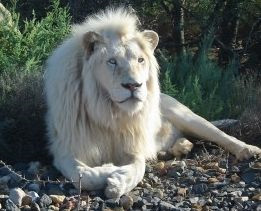Rare White Lions Get Wild

A pride of white lions, including two adult males and two juvenile females, has been released into Sanbona Wildlife Reserve in South Africa's Western Cape Province.
The release is the culmination of a years-long White Lion Project, which was sponsored by the Shamwari Dubai World Africa Conservation team.
The white lions, also called blond lions, are the same species as African lions (Panthera leo). Their blondish-white coloring is the result of a recessive mutant gene. So cubs born to more tawny-colored lions could carry the recessive mutant gene (without showing a blond coat) and pass it on to future generations. Like most recessive genes, if an offspring gets two copies of that genetic mutation, the trait, such as blondness, will be expressed and show up.
"I think [the white-lion mutation] might have been observed in a wild population of lions in South Africa. We've seen naturally occurring mutations from time to time in the wild," said George Amato, a conservation biologist and geneticist at the American Museum of Natural History in New York. Amato was not involved in the lion release.
According to the Project scientists, white lions were first spoted in the wild 400 years ago, then again in 1928, and then 50 years later a litter of two white cubs was documented at Timbvati Game Reserve in South Africa.
Even though white lions are rare in the wild, breeding programs, zoos and circuses have made more of them.
"My guess is that they probably increased the frequency of that mutation either through selective breeding or inbreeding," Amato said.
Get the world’s most fascinating discoveries delivered straight to your inbox.
Whether blond or tawny-colored, African lion populations are dwindling, due to poaching, habitat destruction (from land development) and diseases. . The IUCN, or International Union for Conservation of Nature, lists the species as "vulnerable," and "regionally endangered" in West Africa. Conservation efforts generally aim to reduce human impacts on animals suffering in the wild.
"Conservation as an endeavor is basically about trying to maintain elements of the naturally occurring system to the best that you can," Amato said.
While the blond lions are a pretty sight in their wild environment, their coloring could belie health issues. That's because in order to maintain the white coloring, the lions had to be inbred, ensuring two copies of the recessive mutation would get passed down to offspring.
"The best way to try to create more of them is to inbreed them," Amato told LiveScience. "But then there are a lot of problems with inbreeding, because not only are you more likely to get two copies of that same mutation [for white coloring], you're also likely to get two copies of the rare deleterious mutations that all individuals have. That's generally why inbreeding is bad."
In addition, inbreeding reduces genetic variability, meaning the lions' immune systems could be weaker than that of their relatives.
Members of the White Lion Project wanted to boost the genetic integrity of captive-bred white lions. To do this, the researchers bred the offspring of white lions with the tawny-colored variety.
Currently, the pride is being closely monitored by members of the Shamwari Dubai World Africa Conservation team. While the pride members may separate and wander, the pride released at Sanbona Wildlife Reserve's 100,000 acres (40,000 hectares) will ultimately reunite, the Sanbona scientists say.
- Watch the White Lions
- Top 10 Deadliest Animals
- Image Gallery: The World's Biggest Beasts
Jeanna Bryner is managing editor of Scientific American. Previously she was editor in chief of Live Science and, prior to that, an editor at Scholastic's Science World magazine. Bryner has an English degree from Salisbury University, a master's degree in biogeochemistry and environmental sciences from the University of Maryland and a graduate science journalism degree from New York University. She has worked as a biologist in Florida, where she monitored wetlands and did field surveys for endangered species, including the gorgeous Florida Scrub Jay. She also received an ocean sciences journalism fellowship from the Woods Hole Oceanographic Institution. She is a firm believer that science is for everyone and that just about everything can be viewed through the lens of science.


